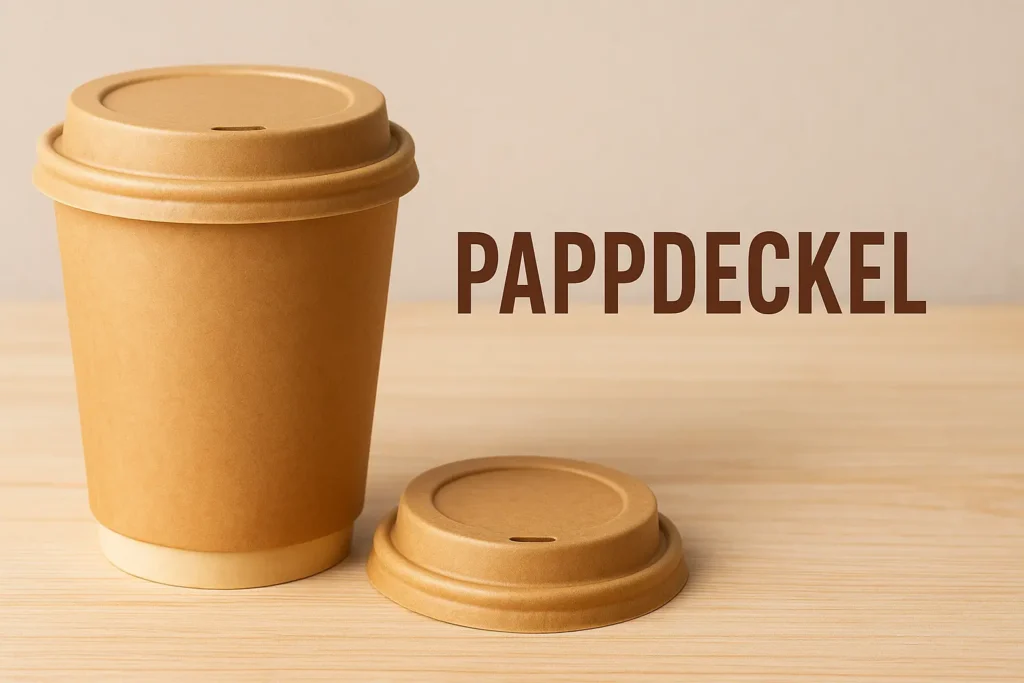A pappedeckel may look like an everyday throwaway item, but it has a surprisingly big story behind it. Used across cafés, bakeries, catering services, and even in creative industries, this humble cardboard lid combines functionality, sustainability, and branding opportunities in a way that plastic often cannot. In this in-depth guide, we’ll explore everything about the pappedeckel — from its definition and materials to its environmental impact, customization options, and market trends — so you can see why it is becoming a preferred choice worldwide.
Understanding What a Pappedeckel Is?
The word “pappedeckel” comes from German, where “Pappe” means cardboard and “Deckel” means lid. As the name suggests, it is a lid made from cardboard or paperboard, designed to fit over cups, bowls, trays, or other containers. It’s lightweight, cost-effective, and versatile. While the most common image is a circular lid for coffee cups, the pappedeckel actually comes in various shapes and sizes to suit different industries.
Unlike plastic lids, which are made from petroleum-based materials, a pappedeckel can be made entirely from renewable plant fibers. It can also be produced in both coated and uncoated forms, depending on whether the contents are hot, cold, dry, or moist.
Materials Used in a Pappedeckel
The performance of a pappedeckel depends heavily on its raw materials. The most common choices include:
- Recycled cardboard – Made from post-consumer paper waste, this is an eco-friendly and cost-effective choice.
- Virgin fiberboard – Stronger and more consistent in texture, often used when a premium finish is required.
- Compostable coated board – Treated with plant-based or biodegradable coatings to provide resistance to liquids and oils.
- Waxed board – Light wax coating for greasy or oily foods.
The manufacturing process starts with pulping — breaking down paper fibers — then pressing the material into sheets, drying it, and cutting it into precise shapes using die-cut machines. For larger orders, lids can be embossed, printed, or even stamped with promotional designs before packaging.
Common Uses of a Pappedeckel
The pappedeckel is most famously associated with takeaway coffee, but its uses extend far beyond that. Here are some of the main applications:
- Food and beverage industry – Coffee cups, soup containers, ice cream tubs, and bakery boxes often use a pappedeckel to keep products fresh and spill-free.
- Events and catering – Disposable trays, portion cups, and drink carriers rely on these lids for transportation.
- Hospitality – Restaurants and bars sometimes use them as drink coasters, both functional and branded.
- Arts and crafts – The strong yet cuttable cardboard makes a pappedeckel useful for creative projects, DIY decorations, or prototypes.
- Industrial packaging – Acts as separators, dust covers, or liners for certain goods.
Its adaptability is one reason the pappedeckel remains relevant in so many different markets.
Environmental Advantages
One of the strongest arguments for using a pappedeckel over plastic is sustainability. Cardboard lids are biodegradable, compostable, and often recyclable. Here’s why they’re a better choice for the planet:
- Lower carbon footprint – Producing a pappedeckel generally consumes less energy than producing petroleum-based plastics.
- Renewable raw materials – When sourced from certified forests, cardboard helps support sustainable forestry practices.
- Waste reduction – In composting facilities, a pappedeckel can break down within weeks, leaving no harmful microplastics behind.
- Consumer appeal – Environmentally conscious customers are more likely to support brands that use eco-friendly packaging.
However, not all pappedeckel products are equally sustainable. Some coatings or inks can reduce recyclability, so choosing certified compostable or uncoated versions is important for true environmental benefit.
Printing, Branding, and Marketing Potential
A plain lid does its job, but a printed pappedeckel becomes a mini billboard. Businesses can add logos, slogans, QR codes, or seasonal designs to make their packaging stand out. Common printing methods include:
- Flexographic printing – Good for large-scale runs with simple designs.
- Offset printing – Produces sharp, high-quality images and is great for intricate patterns.
- Digital printing – Perfect for smaller batches or frequent design changes.
Branding a pappedeckel not only increases recognition but also communicates professionalism and attention to detail. A well-designed lid can leave a lasting impression with customers, encouraging repeat visits.
Choosing the Right Pappedeckel for Your Needs
Not all pappedeckel products are created equal. Choosing the right one means looking at:
- Size and fit – Make sure the lid fits your container perfectly to avoid leaks.
- Material and coating – Match the material to your product; for hot drinks, coated lids work best.
- Order volume – Bulk orders save money, but small batches allow for design flexibility.
- Sustainability certifications – Look for FSC, PEFC, or compostable certifications to ensure eco-friendly sourcing.
Testing samples before a full order is always a smart move, especially for businesses that want to maintain product quality and customer satisfaction.
Disposal and Recycling Guidelines
For the pappedeckel to live up to its eco-friendly reputation, proper disposal is crucial. Here’s a simple breakdown:
- Uncoated cardboard lids – Can usually be recycled with paper waste.
- Coated compostable lids – Should go into compost bins where facilities exist.
- Waxed lids – May be compostable but not always recyclable.
Clear labeling helps customers dispose of the pappedeckel correctly, reducing contamination in recycling streams.
Cost Factors and Market Trends
The cost of a pappedeckel depends on materials, coatings, printing, and quantity. Uncoated recycled lids are typically the most affordable, while custom-printed compostable-coated lids are more expensive.
Market trends show a steady increase in demand for eco-friendly packaging. Many governments are also introducing restrictions on single-use plastics, pushing businesses toward fiber-based alternatives. As a result, suppliers are expanding their pappedeckel offerings, making them more accessible and customizable than ever.
Conclusion
The pappedeckel is more than just a lid — it’s a tool for protecting products, promoting sustainability, and enhancing brand identity. Businesses that switch to cardboard lids not only reduce environmental impact but also appeal to a growing base of eco-conscious customers. Whether you’re a café owner, event planner, or packaging supplier, choosing the right pappedeckel can be a small change with a big positive effect.
FAQs
1. What materials are used in a pappedeckel?
It is usually made from recycled cardboard, virgin fiberboard, or coated compostable board.
2. Can I print my logo on a pappedeckel?
Yes, cardboard lids are ideal for printing logos, slogans, and custom designs.
3. Is a pappedeckel safe for hot drinks?
Yes, especially when made with a heat-resistant or compostable coating.
4. Are all pappedeckel products compostable?
Not all — compostability depends on the material and coating used.
5. Why is a pappedeckel better than a plastic lid?
It’s more sustainable, recyclable, biodegradable, and better for the environment.

